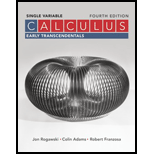
(a)
Domain of the given
Answer to Problem 1CRE
Solution:
Domain of the given vector-valued function is .
Explanation of Solution
Given:
We have been given a vector valued function:
Key concepts used:
Domain of a rational function is all real numbers except when denominator is zero. Domain of inverse sine function is
Calculation:
In order to find the domain of a vector valued function, we find the domains of all the components of the vector function and then we consider the intersection of all the domains.
Domain of the first component is all real numbers except 0. Thus, domain of the first component is .
Domain of the second component is all real numbers except . Thus, domain of the second component is .
Domain of the third component is .
For writing the domain of the entire vector valued function, we consider the intersection of all three domains. Thus, the domain of the given vector valued function is .
Conclusion:
The domain of the given vector valued function has been found by first finding the domains of each of the components and then considering the intersection.
(b)
Domain of the given vector valued function.
Answer to Problem 1CRE
Solution:
Domain of the given vector-valued function is .
Explanation of Solution
Given:
We have been given a vector valued function:
Key concepts used:
Domain of a rational function is all real numbers except when denominator is zero. Domain of inverse sine function is
Calculation:
In order to find the domain of a vector valued function, we find the domains of all the components of the vector function and then we consider the intersection of all the domains.
Domain of the first component is .
Domain of the second component is .
Domain of the third component is .
For writing the domain of the entire vector valued function, we consider the intersection of all three domains. Thus, the domain of the given vector valued function is .
Conclusion:
The domain of the given vector valued function has been found by first finding the domains of each of the components and then considering the intersection.
Want to see more full solutions like this?
Chapter 13 Solutions
Loose-Leaf Version for Calculus: Early Transcendentals Single Variable
- Please focus on ix.arrow_forwardPlease focus on vi.arrow_forward的 v If A is an n x n matrix that is not invertible, then A. rank(A) = n C. det(A) = 0 B. Reduced row-echelon form of A = In D. AB BA= In for some matrix B 63°F Partly sunny Q Search 3 $ 4 40 FS 96 S W E A S T FG S Y & コ B ㅁ F G H J 4 Z X C V B N M 9 H V FIB - FIB ㅁ P L ว DELETE BACHSPACE LOCK L ? PAUSE ALT CTRL ENTER 7 2:20 PM 4/14/2025 HOME J INSERT SHIFT END 5arrow_forward
- i Compute the given determinant by cofactor expansions. At each step, choose a row or columnthat involves the least amount of computation.7 6 8 40 0 0 68 7 9 30 4 0 5arrow_forwardi Compute the inverse of the matrix below using row operations. Please show your work.1 0 −2−3 1 42 −3 4 This is a 3*3 matrix. First row is 1 0 -2.arrow_forwardSolve the system of equations below by applying row operations on the corresponding aug-mented matrix to convert it to the reduced row-echelon form. Write the solutions using freevariables as parameters.x1 + 3x2 + x3 = 1−4x1 − 9x2 + 2x3 = −1−3x2 − 6x3 = −3arrow_forward
 Calculus: Early TranscendentalsCalculusISBN:9781285741550Author:James StewartPublisher:Cengage Learning
Calculus: Early TranscendentalsCalculusISBN:9781285741550Author:James StewartPublisher:Cengage Learning Thomas' Calculus (14th Edition)CalculusISBN:9780134438986Author:Joel R. Hass, Christopher E. Heil, Maurice D. WeirPublisher:PEARSON
Thomas' Calculus (14th Edition)CalculusISBN:9780134438986Author:Joel R. Hass, Christopher E. Heil, Maurice D. WeirPublisher:PEARSON Calculus: Early Transcendentals (3rd Edition)CalculusISBN:9780134763644Author:William L. Briggs, Lyle Cochran, Bernard Gillett, Eric SchulzPublisher:PEARSON
Calculus: Early Transcendentals (3rd Edition)CalculusISBN:9780134763644Author:William L. Briggs, Lyle Cochran, Bernard Gillett, Eric SchulzPublisher:PEARSON Calculus: Early TranscendentalsCalculusISBN:9781319050740Author:Jon Rogawski, Colin Adams, Robert FranzosaPublisher:W. H. Freeman
Calculus: Early TranscendentalsCalculusISBN:9781319050740Author:Jon Rogawski, Colin Adams, Robert FranzosaPublisher:W. H. Freeman
 Calculus: Early Transcendental FunctionsCalculusISBN:9781337552516Author:Ron Larson, Bruce H. EdwardsPublisher:Cengage Learning
Calculus: Early Transcendental FunctionsCalculusISBN:9781337552516Author:Ron Larson, Bruce H. EdwardsPublisher:Cengage Learning





